10. Cooperation between enterprises and universities and working together
In connection with the Innovation Survey, enterprises were inquired now for the first time more extensively about cooperation with universities. Cooperation between enterprises and universities here means organised, active cooperation, as well as other transfer of know-how, collaboration and goal-oriented interaction or communication. Cooperation covers both innovation cooperation and other cooperation with both domestic and foreign universities suitable for the definition.
Around one-fifth of enterprises reported cooperation with universities in 2014 to 2016. In total, 13 per cent reported innovation cooperation with universities. Similarly, 13 per cent reported other than innovation cooperation.
About seven per cent of enterprises reported only innovation cooperation with universities, not any other type of cooperation as meant in the inquiry, in 2014 to 2016. Similarly, seven per cent had done both innovation cooperation and other cooperation. In relative terms, an equally large group of enterprises – six per cent of the target group – had done only other than innovation cooperation.
Cooperation became more common as the enterprise size grew and in manufacturing, the share of those having reported cooperation was larger than in services.
Nearly all having reported cooperation worked together with domestic universities, and nearly four per cent said they had cooperated with foreign universities.
Table 4. Collaboration with universities 2014–2016, share of enterprises
| Collaboration | Cooperation with domestic universities |
Cooperation with foreign universities |
||
| % | % | % | ||
| All NACE
-Total (number of enterprises 8491) |
Innovation cooperation | 13.5 | 13.0 | 2.9 |
| Other cooperation | 12.6 | 12.1 | 1.5 | |
|
Manufacturing (number of enterprises 3747) |
Innovation cooperation | 18.5 | 18.1 | 4.1 |
| Other cooperation | 14.8 | 14.3 | 2.3 | |
| Services (number of enterprises 4744) |
Innovation cooperation | 9.5 | 9.1 | 2.0 |
| Other cooperation | 11.0 | 10.4 | 0.9 | |
Table 5. Collaboration with universities 2014–2016, share of all enterprises
| All
enterprises (Number of enterprises 8491) |
Share of enterprises with cooperation |
Cooperation only with domestic universities |
Cooperation both with domestic and foreign universities |
Cooperation only with foreign universities |
||
| % | % | % | % | |||
| Share of enterprises with cooperation | % | 19.2 | ||||
| Only innovation cooperation | % | 5.2 | 1.1 | 0.2 | ||
| Both innovation cooperation and other cooperation | % | 4.9 | 1.8 | 0.1 | ||
| Only other cooperation | % | 5.5 | 0.1 | 0.2 | ||
Table 6. Collaboration with universities in manufacturing 2014–2016, share of all enterprises
|
Manufacturing (Number of enterprises 3747) |
Share of enterprises with cooperation |
Cooperation only with domestic universities |
Cooperation both with domestic and foreign universities | Cooperation only with foreign universities |
||
| % | % | % | % | |||
| Share of enterprises with cooperation | % | 24.2 | ||||
| Only innovation cooperation | % | 7.6 | 1.6 | 0.2 | ||
| Both innovation cooperation and other cooperation | % | 6.4 | 2.6 | 0.1 | ||
| Only other cooperation | % | 5.0 | 0.2 | 0.4 | ||
Table 7. Collaboration with universities in services 2014–2016, share of all enterprises
|
Services (Number of enterprises 4744) |
Share of enterprises with cooperation |
Cooperation only with domestic universities |
Cooperation both with domestic and foreign universities | Cooperation only with foreign universities |
||
| % | % | % | % | |||
| Share of enterprises with cooperation | % | 15.3 | ||||
| Only innovation cooperation | % | 3.3 | 0.8 | 0.3 | ||
| Both innovation cooperation and other cooperation | % | 3.7 | 1.2 | 0.1 | ||
| Only other cooperation | % | 5.8 | 0.0 | 0.0 | ||
The share of those having had university cooperation in manufacturing was 24 per cent in 2014 to 2016. Nearly all of them reported cooperation with domestic universities, and five per cent of enterprises, that is, around every fifth of those having collaborated, had cooperated with foreign universities. In service industries, the share of enterprises having had university cooperation was 15 per cent of all surveyed enterprises. Similarly as in manufacturing, nearly all of them had had cooperation with domestic universities. In turn, a couple of per cent reported cooperation with foreign universities.
Nearly one-fifth of manufacturing enterprises reported innovation cooperation in this connection, and good ten per cent other cooperation. The respective proportions in services were around 10 and 11 per cent.
The examination by industry shows that in manufacturing the industries that had university cooperation most commonly were the manufacture of computer, electronic and optical products, the manufacture of chemicals and chemical products, and the manufacture of paper and paper products. In the first two mentioned ones, as in the manufacture of basic metals, mining and quarrying, and the manufacture of furniture, the share of those having cooperated with foreign universities was one of the highest in the data.
In services, in turn, enterprises in research and development and computer programming most often collaborated with universities, of whom one-quarter also with foreign universities.
Figure 27. Those having had university cooperation in manufacturing in 2014 to 2016, share of all
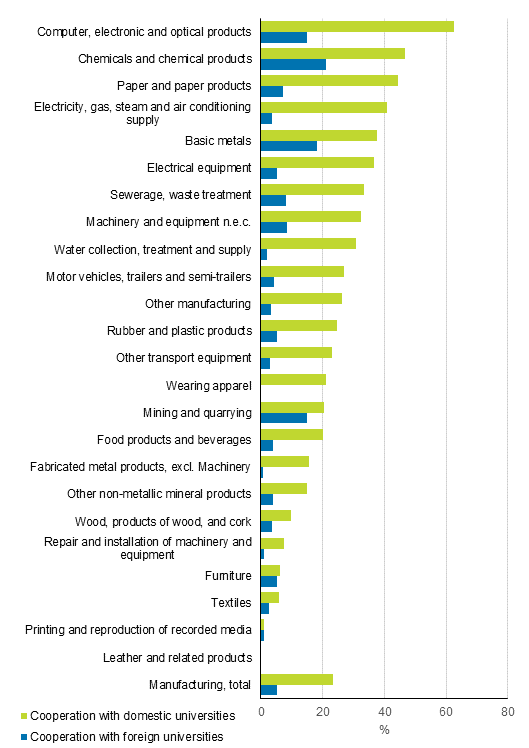
Figure 28. Those having had university cooperation in services in 2014 to 2016, share of all
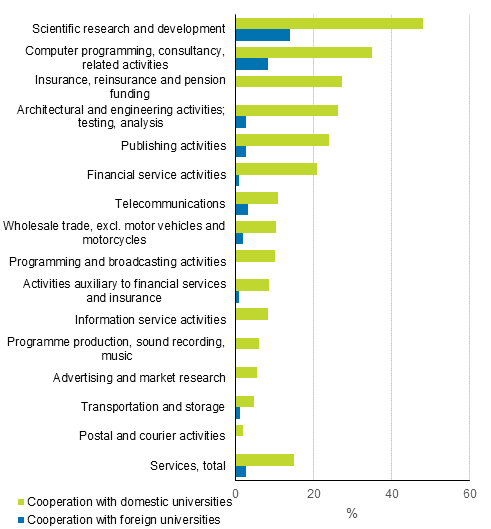
In many fields, a considerable share of those having cooperated had had both innovation cooperation and other cooperation with universities. For example, three out of four having cooperated in computers, electronic and optical equipment had had innovation cooperation, while over one half had had other than innovation cooperation. In services, in computer programming, for example, around one third did only innovation cooperation, another third both innovation and other cooperation and the remaining third only other than innovation cooperation. More detailed data by industry can be found in the database tables on the home page of the statistics http://pxnet2.stat.fi/PXWeb/pxweb/en/StatFin/StatFin__ttt__inn/?rxid=bc3e89c0-f7db-4a3d-99a8-8fb9999226de
Figure 29. Innovation cooperation and other university cooperation in manufacturing in 2014 to 2016, share of all
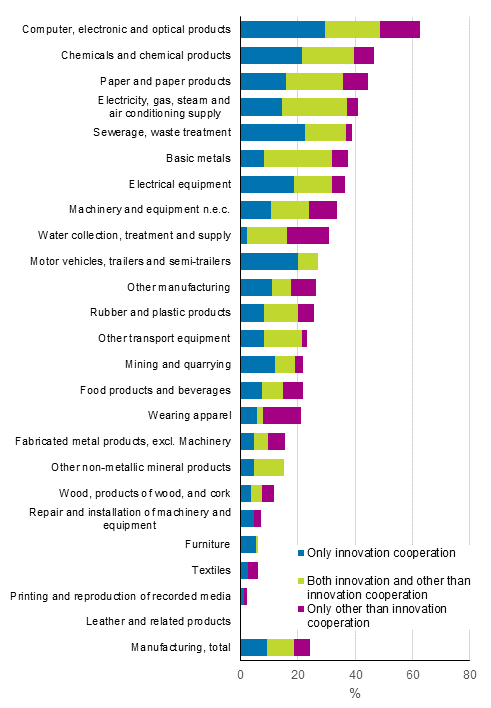
Figure 30. Innovation cooperation and other university cooperation in manufacturing in 2014 to 2016, share of all
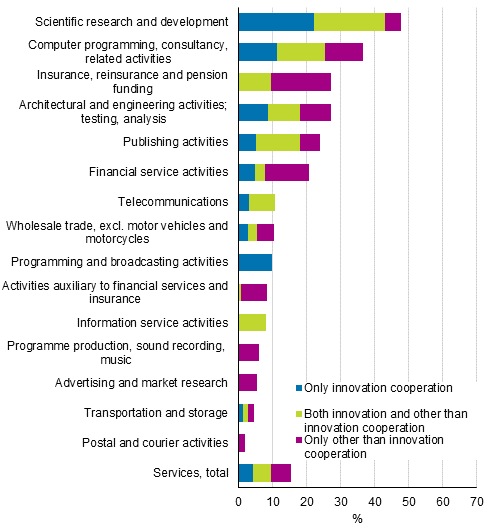
Of the results of university cooperation, enterprises thought most important were strengthening the knowledge base and competence, overview of future trends and markets, introduction of new technologies, methods or devices and developing new and improved products.
Three out of four of those having cooperated assessed strengthening the knowledge basis and competence as important (importance high or medium) and nearly one-half of them estimated understanding of future trends, introduction of new technologies and development of new products as the important results of cooperation with universities. Around one-quarter of those having had cooperation regarded internationalisation and international activity – access to international markets or its promotion and participation in international research and innovation programmes – as important.
In views and expectations related to the results, university cooperation appears relatively similar in services and manufacturing. Enterprises in service industries, however, estimated views and outlooks related to future trends and markets were more important than manufacturing enterprises, as well as access to international markets and its promotion. Introduction of new technology is, in turn, focused on manufacturing.
Figure 31. Realised or expected results of university cooperation by importance by the end of 2018, share of those that had cooperated in 2014 to 2016
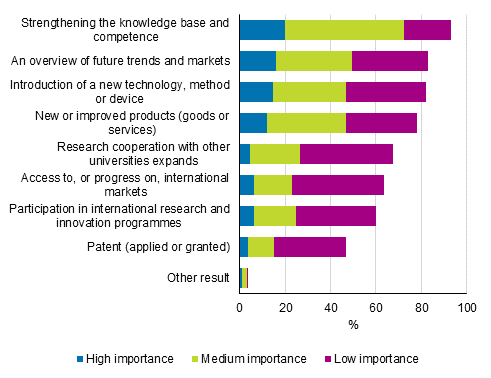
The majority of those having had various types of cooperation with universities feels the collaboration and its forms to have remained similar to before in 2014 to 2016. Most growth concerned recruitment of new experts from universities, cooperation made through graduation theses, innovation-oriented joint development and contracted out R&D.
However, the development of cooperation and changes felt there differ somewhat in the responses of manufacturing enterprises and service enterprises. Every fourth service enterprise having had university cooperation estimated that recruitment of new experts from universities had increased and its importance had grown from before. The share in manufacturing was some 10 per cent. Contracted out R&D was again a more relevant form of cooperation for manufacturing enterprises, 15 per cent of which reported collaboration had grown along with them in 2014 to 2016 compared with earlier. Nearly one-half estimated the situation of contracted out research had remained unchanged. In services, over one-half, 54 per cent considered contracted out R&D a non-relevant cooperation form. The situation is similar in the use of universities’ research and laboratory infrastructure and services; they are relevant and have increased in importance more in manufacturing enterprises than in service enterprises.
The growing significance of university cooperation is visible in enterprises of all sizes. Of the smallest cooperators, 13 per cent refer to growth in the importance of contracted out research, 15 per cent of medium-sized ones and 12 per cent of large ones. The importance of universities’ research and laboratory infrastructure and services has grown for 11 per cent of the smallest enterprises, similarly for 11 per cent of medium-sized enterprises and for 15 per cent of the largest enterprises. Large enterprises have noted more often than small ones that the importance of recruitment from universities and joint development of innovations have grown. The smallest enterprises in the data, in turn, noticed growth in the importance of theses, in particular.
Figure 32. Development of forms and importance of university cooperation compared to before in 2014 to 2016, share of those having cooperated with universities
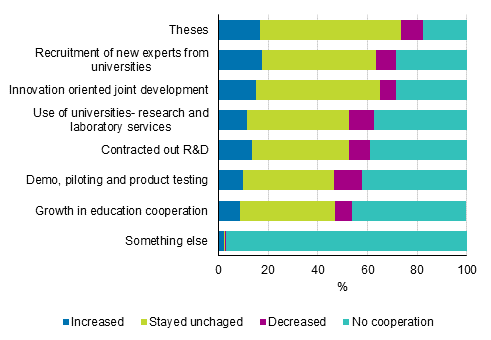
Every fourth enterprise intended to cooperate with universities in 2017 to 2018. As realised cooperation, intentions become more common as the enterprise size grows.
Nearly all that had planned cooperation were going to cooperate with Finnish universities. Six per cent of enterprises were going to work together with foreign universities.
In manufacturing, almost every third enterprise had cooperation intentions. For example, nearly one-half of the biggest manufacturing enterprises in the data intended to cooperate with both Finnish and foreign universities. In service industries, every fifth enterprise was planning cooperation, nearly one-half of large enterprises.
Source: Innovation 2016, Statistics Finland
Inquiries: Mervi Niemi 029 551 3263, Heidi Pirkola 029 551 3246, tiede.teknologia@stat.fi
Director in charge: Sami Saarikivi
Updated 12.4.2018
Official Statistics of Finland (OSF):
Innovation [e-publication].
ISSN=1797-4399. 2016,
10. Cooperation between enterprises and universities and working together
. Helsinki: Statistics Finland [referred: 16.12.2025].
Access method: http://stat.fi/til/inn/2016/inn_2016_2018-04-12_kat_010_en.html

